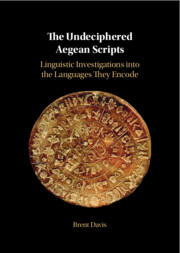Refine search
Actions for selected content:
6455 results in Classical Archaeology
Roman Rural Archaeology
- Society, Economy, and Culture
- Coming soon
-
- Expected online publication date:
- July 2026
- Print publication:
- 31 July 2026
-
- Book
- Export citation

The Archaic and Early Classical Greek World
- Using Coins as Sources
- Coming soon
-
- Expected online publication date:
- May 2026
- Print publication:
- 31 May 2026
-
- Textbook
- Export citation
Living Precariously in the Roman World
- A Social Archaeology of Inequality
- Coming soon
-
- Expected online publication date:
- May 2026
- Print publication:
- 31 May 2026
-
- Book
- Export citation
Architecture and Politics in Mycenaean Greece
- Stoneworking, Labor, and Regional Ties in the Late Bronze Age
- Coming soon
-
- Expected online publication date:
- April 2026
- Print publication:
- 30 April 2026
-
- Book
- Export citation

The Subura of Rome
- Landscape and Ideology from the Iron Age to the Early Middle Ages
- Coming soon
-
- Expected online publication date:
- April 2026
- Print publication:
- 31 May 2026
-
- Book
- Export citation

The Cambridge Companion to the Greek Iron Age
- Coming soon
-
- Expected online publication date:
- April 2026
- Print publication:
- 30 April 2026
-
- Book
- Export citation

The Undeciphered Aegean Scripts
- Linguistic Investigations into the Languages They Encode
- Coming soon
-
- Expected online publication date:
- February 2026
- Print publication:
- 28 February 2026
-
- Book
- Export citation

The Topography and Monuments of Ancient Rome
- Coming soon
-
- Expected online publication date:
- January 2026
- Print publication:
- 31 January 2026
-
- Book
- Export citation
7 - Religion
-
- Book:
- Mycenaean Civilization
- Published online:
- 19 December 2025
- Print publication:
- 15 January 2026, pp 488-512
-
- Chapter
- Export citation
Preface
-
- Book:
- Mycenaean Civilization
- Published online:
- 19 December 2025
- Print publication:
- 15 January 2026, pp xv-xv
-
- Chapter
- Export citation
2 - The Late Helladic I Period
-
- Book:
- Mycenaean Civilization
- Published online:
- 19 December 2025
- Print publication:
- 15 January 2026, pp 103-178
-
- Chapter
- Export citation
6 - Writing
-
- Book:
- Mycenaean Civilization
- Published online:
- 19 December 2025
- Print publication:
- 15 January 2026, pp 474-487
-
- Chapter
- Export citation
Contents
-
- Book:
- Mycenaean Civilization
- Published online:
- 19 December 2025
- Print publication:
- 15 January 2026, pp v-vii
-
- Chapter
- Export citation
Foreword
-
-
- Book:
- Mycenaean Civilization
- Published online:
- 19 December 2025
- Print publication:
- 15 January 2026, pp viii-xiv
-
- Chapter
- Export citation
Copyright page
-
- Book:
- Mycenaean Civilization
- Published online:
- 19 December 2025
- Print publication:
- 15 January 2026, pp iv-iv
-
- Chapter
- Export citation
Chronological Chart
-
- Book:
- Mycenaean Civilization
- Published online:
- 19 December 2025
- Print publication:
- 15 January 2026, pp 580-580
-
- Chapter
- Export citation
Figures and Sources of Photographs
-
- Book:
- Mycenaean Civilization
- Published online:
- 19 December 2025
- Print publication:
- 15 January 2026, pp 671-701
-
- Chapter
- Export citation
1 - The Bronze Age Civilization of Greece
-
- Book:
- Mycenaean Civilization
- Published online:
- 19 December 2025
- Print publication:
- 15 January 2026, pp 1-102
-
- Chapter
- Export citation
5 - Pottery
-
- Book:
- Mycenaean Civilization
- Published online:
- 19 December 2025
- Print publication:
- 15 January 2026, pp 428-473
-
- Chapter
- Export citation
10 - Mycenaean Greece in Homer
-
- Book:
- Mycenaean Civilization
- Published online:
- 19 December 2025
- Print publication:
- 15 January 2026, pp 566-579
-
- Chapter
- Export citation
